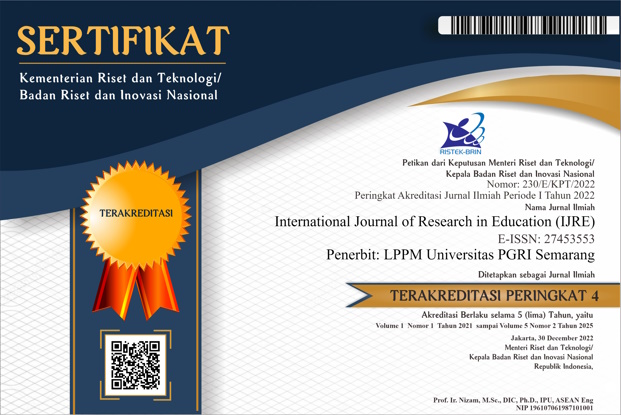Promoting Speaking Skills Through English Storytelling in Madrasah Diniyah: An Islamic Non-Formal School in Indonesia
DOI:
https://doi.org/10.26877/ijre.v4i2.821Keywords:
Speaking skills, teaching speaking, English storytelling, Madrasah DiniyahAbstract
Since English is used frequently in everyday life, exposure to it is essential in non-formal education. Using storytelling techniques and incorporating English as local content can help create a new learning environment and combat boredom that stems from formal school fatigue. This study investigated how English storytelling can enhance speaking ability and foster a positive attitude toward learning English among non-formal school students. The research involved 52 students at Madrasah Diniyah, an Islamic non-formal school in Central Java utilizing test, questionnaire, and parent interviews. The research findings showed that the English Storytelling Technique can increase students' motivation to learn in non-formal schools and also improve their speaking ability. This is evidenced by the significant improvement in students' speaking ability, increasing from the initial level of 55% to 87% at the final level. The student's parents believe that because the Islamic non-formal school offers English language instruction, their children are more encouraged to learn the language. Therefore, the study suggests that the exposure of English learning should be given more and intensively to non-formal school in the future learning.
References
Abrahamson, C. E. (1998). Storytelling as a pedagogical tool in higher education. Education, 118(3), 440–452.
Almeida, F., & Morais, J. (2024). Non-formal education as a response to social problems in developing countries. E-Learning and Digital Media. https://doi.org/10.1177/20427530241231843
Alsofi, A. A. (2008). The Effectiveness of Using Storytelling Technique in Enhancing 11 th Graders’ Listening Comprehension Sub-Skills in Middle Gaza Governorate. Unpublished Master‟ s Thesis. Gaza: The Islamic University.
Alterio, M., & McDrury, J. (2003). Learning through storytelling in higher education: Using reflection and experience to improve learning. Routledge.
Barzaq, M. (2009). Integrating sequential thinking thought teaching stories in the curriculum. Action Research. AlQattan Center for Educational Research and Development QCERD.
Breene, C. (2012). Revealing practices. Visible, 19(1), 13.
Brown, H. D., & Abeywickrama, P. (2018). Language assessment. Principles and Classroom Practices. White Plains, NY: Pearson Education.
Burns, A. (2019). Concepts for Teaching Speaking in the English Language Classroom 1. Journal: Language Education and Acquisition Research Network Journal, 12(1).
Caine, R. N., Caine, G., McClintic, C., & Klimek, K. (2005). 12 brain/mind learning principles in action: The fieldbook for making connections, teaching, and the human brain. Corwin Press.
Champion, T. B. (2014). Understanding storytelling among African American children: A journey from Africa to America. Routledge.
Davies, A. (2007). Storytelling in the Classroom: Enhancing Oral and Traditional Skills for Teachers;[age Range 5-11]. Chapman.
Diana, R. C. (2013). Ar Qurani (Al Ibrah Qurani): Upaya Internalisasi Nilai-Nilai Qurani Pada Anak Muslim Indonesia Berbasis Modul Kisah Teladan Al Qur’an. Jurnal Pendidikan Nasional, 2(3).
Fox, C. (1993). At the very edge of the forest: The influence of literature on storytelling by children. (No Title).
Garvie, E. (1990). Story as vehicle: Teaching English to young children. (No Title).
Hanifah, D. F., & Heriyudanta, M. (2022). IMPLEMENTASI METODE BERKISAH DALAM MENUMBUHKAN MINAT BELAJAR SANTRI DI MADRASAH DINIYAH “AR-ROHMAN” Dsn. LOBANG, MLILIR, DOLOPO, MADIUN. Al-Lubab: Jurnal Penelitian Pendidikan Dan Keagamaan Islam, 8(1), 1–15.
Harmer, J. (2001). The practice of English language teaching. London/New York, 401–405.
Haven, K. (2000). Super simple storytelling: A can-do guide for every classroom, every day. Libraries Unlimited.
Hughes, R. (2004). Testing the visible: literate biases in oral language testing. Journal of Applied Linguistics, 1(3).
Jannah, F. (2013). Pendidikan Islam dalam sistem pendidikan nasional. Dinamika Ilmu, 13(2).
Kemmis, S. (1983). Orientations to Curriculum and Transition: Towards the Socially-Critical School. ERIC.
Malkina, N. (1995). Storytelling in early language teaching. English Teaching Forum, 33(1), 38–39.
Marliasari, S., & Oktaviani, D. R. (2019). The Effect of Joining Non-Formal Education and English Achievement. Channing: English Language Education and Literature, 4(1).
Rahayu, D. I. (2020). The Acquisition and Learning of EFL in A Non-formal English Education in Indonesia. Journal of English Education, 5(2), 86–94. https://doi.org/10.31327/jee.v5i2.1312
Romi, S., & Schmida, M. (2009). Non-formal education: A major educational force in the postmodern era. Cambridge Journal of Education, 39(2), 257–273. https://doi.org/10.1080/03057640902904472
Syafryadin, Haryani, Salniwati, & Putri, A. R. A. (2019). Digital Storytelling Implementation for Enhancing Students’ Speaking Ability in Various Text Genres. International Journal of Recent Technology and Engineering (IJRTE), 8(4), 3147–3151. https://doi.org/10.35940/ijrte.D8002.118419
Tsou, W., Wang, W., & Tzeng, Y. (2006). Applying a multimedia storytelling website in foreign language learning. Computers & Education, 47(1), 17–28.
Valenzuela, A. (1999). Subtractive schooling: Issues of caring in education of US-Mexican youth. State University of New York Press.
Widodo, W., & Nusantara, W. (2020). Analysis of Non-formal Education (NFE) Needs in Schools. Journal of Nonformal Education, 6(1), 69–76. https://doi.org/10.15294/jne.v6i1.21568
Woolfolk, A. E., Hoy, A. W., Hughes, M., & Walkup, V. (2008). Psychology in education. Pearson Education.
Yusuf, M. (2019). Perkembangan Madrasah Formal Di Indonesia. INTIZAM: Jurnal Manajemen Pendidikan Islam, 2(2), 132–146.



